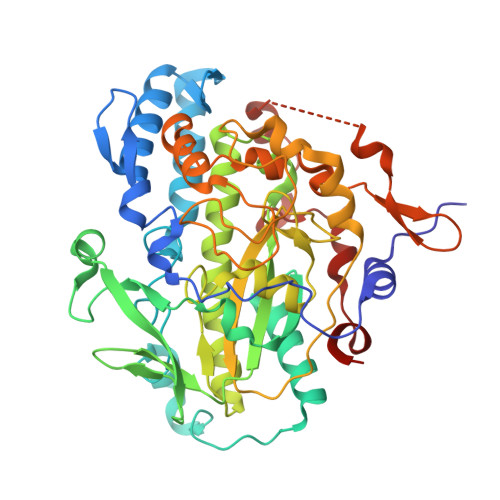Selective Utilization of Benzimidazolyl-Norcobamides as Cofactors by the Tetrachloroethene Reductive Dehalogenase of Sulfurospirillum multivorans.
Keller, S., Kunze, C., Bommer, M., Paetz, C., Menezes, R.C., Svatos, A., Dobbek, H., Schubert, T.(2018) J Bacteriol 200
- PubMed: 29378885
- DOI: https://doi.org/10.1128/JB.00584-17
- Primary Citation of Related Structures:
5OBI, 5OBP - PubMed Abstract:
The organohalide-respiring bacterium Sulfurospirillum multivorans produces a unique cobamide, namely, norpseudo-B 12 , which serves as cofactor of the tetrachloroethene (PCE) reductive dehalogenase (PceA). As previously reported, a replacement of the adeninyl moiety, the lower base of the cofactor, by exogenously applied 5,6-dimethylbenzimidazole led to inactive PceA. To explore the general effect of benzimidazoles on the PCE metabolism, the susceptibility of the organism for guided biosynthesis of various singly substituted benzimidazolyl-norcobamides was investigated, and their use as cofactor by PceA was analyzed. Exogenously applied 5-methylbenzimidazole (5-MeBza), 5-hydroxybenzimidazole (5-OHBza), and 5-methoxybenzimidazole (5-OMeBza) were found to be efficiently incorporated as lower bases into norcobamides (NCbas). Structural analysis of the NCbas by nuclear magnetic resonance spectroscopy uncovered a regioselectivity in the utilization of these precursors for NCba biosynthesis. When 5-MeBza was added, a mixture of 5-MeBza-norcobamide and 6-MeBza-norcobamide was formed, and the PceA enzyme activity was affected. In the presence of 5-OHBza, almost exclusively 6-OHBza-norcobamide was produced, while in the presence of 5-OMeBza, predominantly 5-OMeBza-norcobamide was detected. Both NCbas were incorporated into PceA, and no negative effect on the PceA activity was observed. In crystal structures of PceA, both NCbas were bound in the base-off mode with the 6-OHBza and 5-OMeBza lower bases accommodated by the same solvent-exposed hydrophilic pocket that harbors the adenine as the lower base of authentic norpseudo-B 12 In this study, a selective production of different norcobamide isomers containing singly substituted benzimidazoles as lower bases is shown, and unique structural insights into their utilization as cofactors by a cobamide-containing enzyme are provided. IMPORTANCE Guided biosynthesis of norcobamides containing singly substituted benzimidazoles as lower bases by the organohalide-respiring epsilonproteobacterium Sulfurospirillum multivorans is reported. An unprecedented specificity in the formation of norcobamide isomers containing hydroxylated or methoxylated benzimidazoles was observed that implicated a strict regioselectivity of the norcobamide biosynthesis in the organism. In contrast to 5,6-dimethylbenzimidazolyl-norcobamide, the incorporation of singly substituted benzimidazolyl-norcobamides as a cofactor into the tetrachloroethene reductive dehalogenase was not impaired. The enzyme was found to be functional with different isomers and not limited to the use of adeninyl-norcobamide. Structural analysis of the enzyme equipped with either adeninyl- or benzimidazolyl-norcobamide cofactors visualized for the first time structurally different cobamides bound in base-off conformation to the cofactor-binding site of a cobamide-containing enzyme.
Organizational Affiliation:
Department of Applied and Ecological Microbiology, Institute of Microbiology, Friedrich Schiller University, Jena, Germany.


















